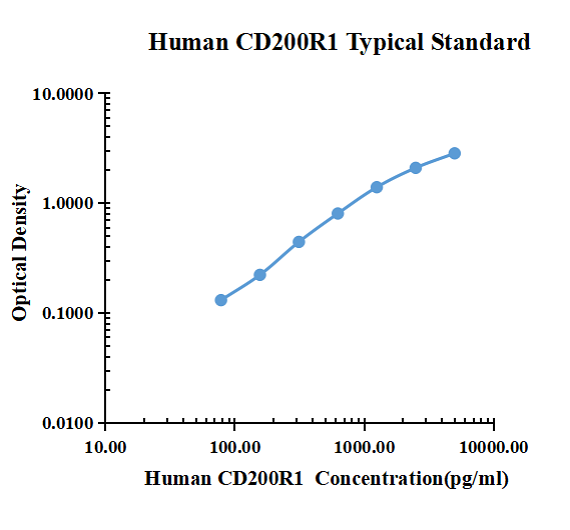Human CD200R1 DTSet enzyme-linked immunoassay kit
| Specification | 96*5 Test;96T*15 Test |
|---|---|
| Standard Curve Range | 78.13 pg/ml-5000pg/ml |
| Standard Curve Gradient | 7 Points/3 Folds |
| Number of Incubations | 2 |
| Detectable sample | Liquid phase sample of soluble substances. For example: serum, plasma, cell culture supernatant, tissue grinding liquid, etc. |
| Sample Volume | 50 μl |
| Type | Not Ready-to-Use |
| Test Duration | 120min |

| pg/ml | O.D. | Average | Corrected | |
|---|---|---|---|---|
| 0.00 | 0.0113 | 0.0125 | 0.0119 | |
| 78.13 | 0.1494 | 0.1367 | 0.1431 | 0.1312 |
| 156.25 | 0.2387 | 0.2306 | 0.2347 | 0.2228 |
| 312.50 | 0.4428 | 0.4693 | 0.4561 | 0.4442 |
| 625.00 | 0.8107 | 0.8232 | 0.8170 | 0.8051 |
| 1250.00 | 1.3730 | 1.4430 | 1.4080 | 1.3961 |
| 2500.00 | 2.1030 | 2.1100 | 2.1065 | 2.0946 |
| 5000.00 | 2.9370 | 2.7660 | 2.8515 | 2.8396 |
Product Features
- Optimized capture and detection antibody pairings with recommended concentrations save lengthy development time
- Development protocols are provided to guide further assay optimization
- Assay can be customized to your specific needs
- Economical alternative to complete kits
Kit Content
- Capture Antibody
- Detection Antibody
- Recombinant Standard
- Streptavidin conjugated to horseradish-peroxidase (Streptavidin-HRP)
Other Reagents Required
DTSet Ancillary Reagent Kit (5 plates): containing 96 well microplates, plate sealers, substrate solution, stop solution, plate coating buffer (PBS), wash buffer, and assay buffer.
- 96 well microplates: YOUKE Life, Catalog # DSEP01. Plate Sealers: YOUKE Life, Catalog # DSSF01.
- Coating Buffer: 137 mM NaCl, 2.7 mM KCl, 8.1 mM Na2HPO4, 1.5 mM KH2PO4, pH 7.2-7.4, 0.2μm filtered . YOUKE Life, Catalog # DSCB01.
- Blocking Buffer: YOUKE Life, Catalog # DSBB01.
- Wash Buffer: 0.05% Tween® 20 in PBS, pH 7.2-7.4. YOUKE Life, Catalog # DSWB01.
- Assay Buffer: 0.5% BSA,0.05% Tween® 20,PBS Solution.YOUKE Life, Catalog # DSAB01
- Substrate Solution: Tetramethylbenzidine. YOUKE Life, Catalog # DSTS01.
- Stop Solution: 0.5mol/ml H2SO4. YOUKE Life, Catalog # DSSS01.
Product Data Sheet
Background: CD200R1
CD200 R1, also known as OX-2 receptor, is a 90 kDa, type I transmembrane protein that belongs to the immunoglobulin superfamily. CD200 R1 is important in the regulation of myeloid cell activity. The mouse CD200 R1 cDNA encodes a 326 aa precursor that includes a 25 aa signal sequence, a 213 aa extracellular domain (ECD), a 21 aa transmembrane segment, and a 67 aa cytoplasmic domain. The ECD is composed of one Ig-like V-type domain and one Ig-like C2-type domain. Within the ECD, mouse CD200 R1 shares 56% and 70% aa sequence identity with human and rat CD200 R1, respectively. The ECD of mouse CD200 R1 shares 69%, 38%, 79%, and 83% aa sequence identity with the ECD of CD200 R2, 3, 4, and a CD200 R-like molecule, respectively. CD200 R1 is expressed primarily on mast cells, basophils, macrophages, and dendritic cells,while its ligand, CD200, is widely distributed. Disruption of this receptor-ligand pair by knockout of the CD200 gene leads to increased macrophage number and activation, plus a predisposition to autoimmune disorders. Association of CD200 with CD200 R1 takes place between their respective N-terminal Ig-like domains. The CD200 R-like molecules may interact differently with CD200. The cytoplasmic domain of CD200 R1 contains two non-ITIM tyrosine residues which are required for propagating its inhibitory signals. CD200 R-like molecules, in contrast, are potentially activating receptors by means of their association with DAP12.

